Audio
Video
Introduction
My favorite lessons and pearls from podcasts and YouTube videos in September 2025. Highlights various clinic topics includingorthostatic hypotension, opioid withdrawal, DOAC failure, HFpEF, delirium, and Hepatitis C!
Orthostatic Hypotension: Gray Matters (Core IM)
Part 1
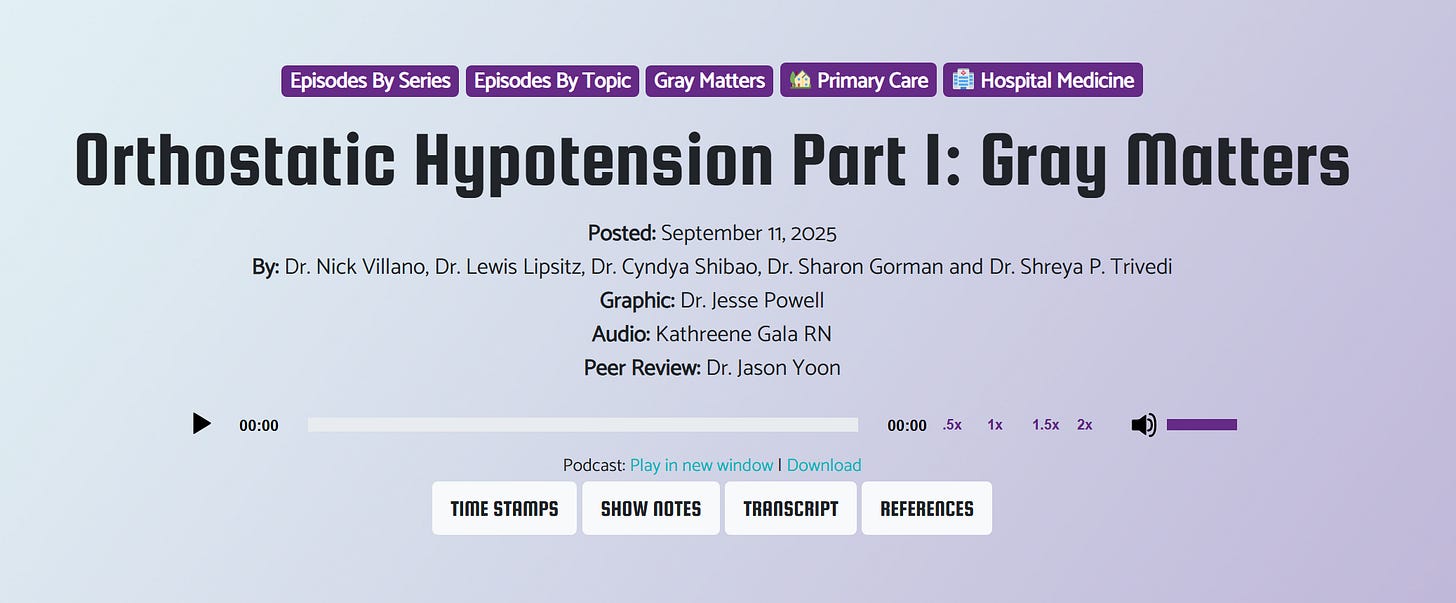
Source: https://www.coreimpodcast.com/2025/09/11/orthostasis-part-1-gray-matters/
- Recommend lying flat for 5 minutes to get stable BP baseline. Check BP at least twice at both the sitting and standing intervals. It may require waiting 5-10 minutes after standing to catch early neurogenic disease which can have a delayed drop in BP.
- HR response can give clue to etiology - ratio of change in HR to change in systolic BP - if HR does not increase by at least one beat per two point drop in SBP (in other words, a ratio of less than 0.5), this strongly suggests blunted autonomic response, such as in diabetic neuropathy
- Treatment should focus on symptoms and functionality and not fixing the orthostatic BP given this may not be possible; that being said, ideally an SBP of 100 when standing should be goal to ensure adequate brain perfusion
- Orthostasis symptoms may also include weakness, blurry vision, mental fog, or coat hanger pain in neck and shoulders caused by poor blood flow to the trapezius muscles
- Promote motility, especially in the hospital - avoid deconditioning just because a patient is a fall risk
- Deprescribe alpha blockers (tamsulosin), beta blockers, nitrates, and alpha-2 agonists (tizanidine) when able
- Thigh-high compression stockings or abdominal binders are the best lifestyle intervention; a significant amount of blood pools in the abdominal circulation upon standing; abdominal binders are often easier to manage in frail adults than compression stockings (don’t have to lean over)
- “Water bolus” trick: having a patient rapidly drink about 16 ounces of cool water can raise their blood pressure for about 30 minutes, acting as a quick rescue measure before beginning activity.
- Patients should be counseled to avoid hot showers and large carbohydrate-heavy meals that can cause postprandial hypotension
Part 2
Source: https://www.coreimpodcast.com/2025/09/22/orthostatic-hypotension-part-2-gray-matters/
- Viewing medications to address orthostasis not as permanent additions, but as a temporary bridge to facilitate mobility and participation in physical therapy can help reframe the clinical decision to start them
- Midodrine is often first line - induces vasoconstriction and raises baseline BP; avoid taking while supine, or when expecting to be supine in next 4 hours to prevent supine hypertension - best in AM or before PT/activity
- Midodrine onset is ~60 minutes, and lasts for 3-4 hours; can check BP at 1 hour mark to see if it is efficacious
- Midodrine can cause urinary retention
- Fludrocortisone helps with volume retention, but may not be the best option in patients with heart failure or baseline HTN; it can also cause hypokalemia; may be a good choice in those with baseline hypotension
- Droxidopa is a prodrug converted into norepinephrine (basically oral levophed), and is approved for neurogenic orthostatic hypotension (in my experience, it is often limited by insurance coverage)
- Patients can have orthostasis symptoms without hypotension if they have HTN at baseline - the BP drop leads to symptoms because the brain is used to the higher pressures, so it experiences relative hypoperfusion
- Severe BP swings are more common in those with neurogenic etiologies - to avoid supine hypertension, recommend sleeping with head of bed elevated
- Supine hypertension can lead to a pressure natriuresis overnight leading to loss of salt and water and this can worsen orthostasis in the AM
- DC from the hospital when SBP is >90-100 and symptoms are overall controlled enough for safe mobility
-
#499 Inpatient DOAC Dilemmas with Dr. Jori May (Curbsiders)
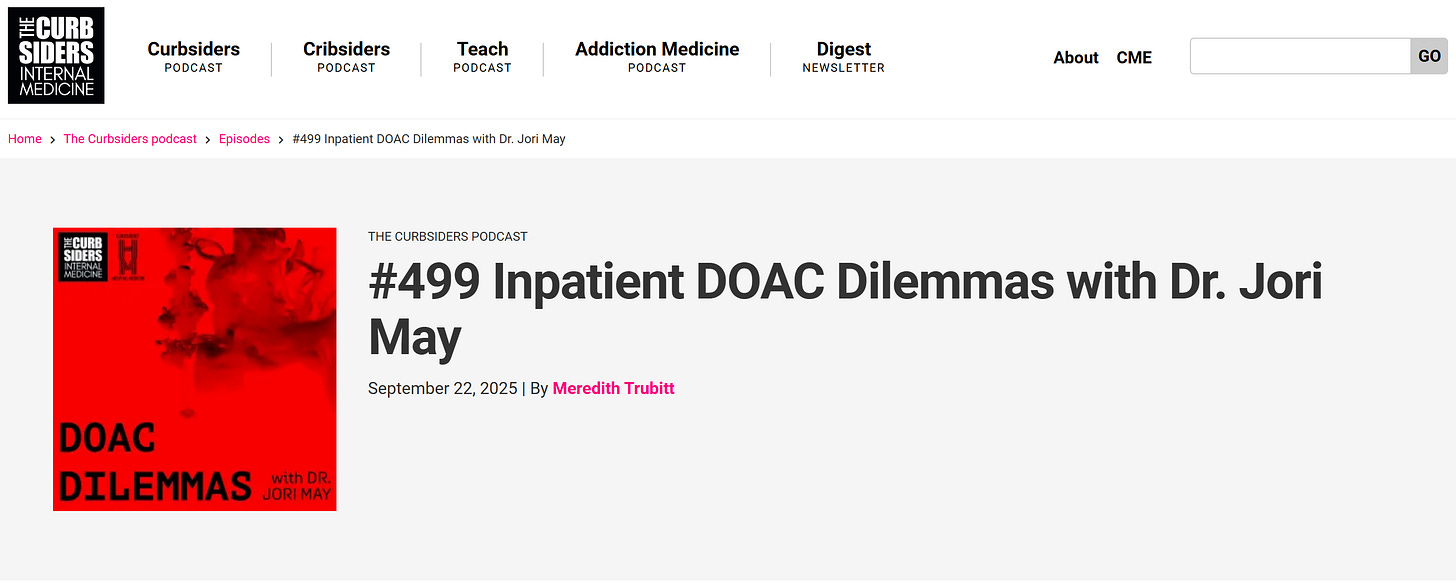
Source: https://thecurbsiders.com/curbsiders-podcast/499-inpatient-doac-dilemmas-with-dr-jori-may
- True anticoagulation failure, defined as definitive evidence of a new thrombus despite adequate anticoagulation, is exceptionally rare
- Confirm patient adherence, not just by asking the patient, but by verifying pharmacy fill histories to ensure consistent access to the medication.
- It is also essential to review the specific administration details; for example, rivaroxaban requires co-administration with food for optimal absorption, and apixaban’s twice-daily dosing schedule must be maintained
- Radiologists can often identify features on ultrasound or CT that distinguish an acute thrombus from a chronic, organized one
- During the initial 1-3 months following a new VTE, some degree of asymptomatic clot propagation or remodeling can occur and does not necessarily represent treatment failure; a normal D-dimer can provide reassurance that a new, significant thrombotic process is less likely, especially when clinical symptoms are chronic or unchanged.
- If true failure, active malignancy or an underlying condition like antiphospholipid syndrome (APS) or anatomic factors like May-Thurner or thoracic outlet syndrome should be considered as possible reasons
- Reasonable to temporarily switch to a parenteral agent like low-molecular-weight heparin (lovenox) while a full investigation is completed.
- Switching to warfarin should not be a reflexive decision; it represents a significant lifestyle change and requires a motivated patient - given the added challenges with adherence, it’s unlikely to be more successful than a DOAC especially if adherence was uncertain to begin with
- In patients with extreme obesity (BMI > 50-60), data on DOAC efficacy are scarce
- For patients with severe renal dysfunction, including those on dialysis, apixaban is often the preferred agent due to its lower degree of renal clearance
#460 Heart Failure with Preserved Ejection Fraction (Curbsiders)
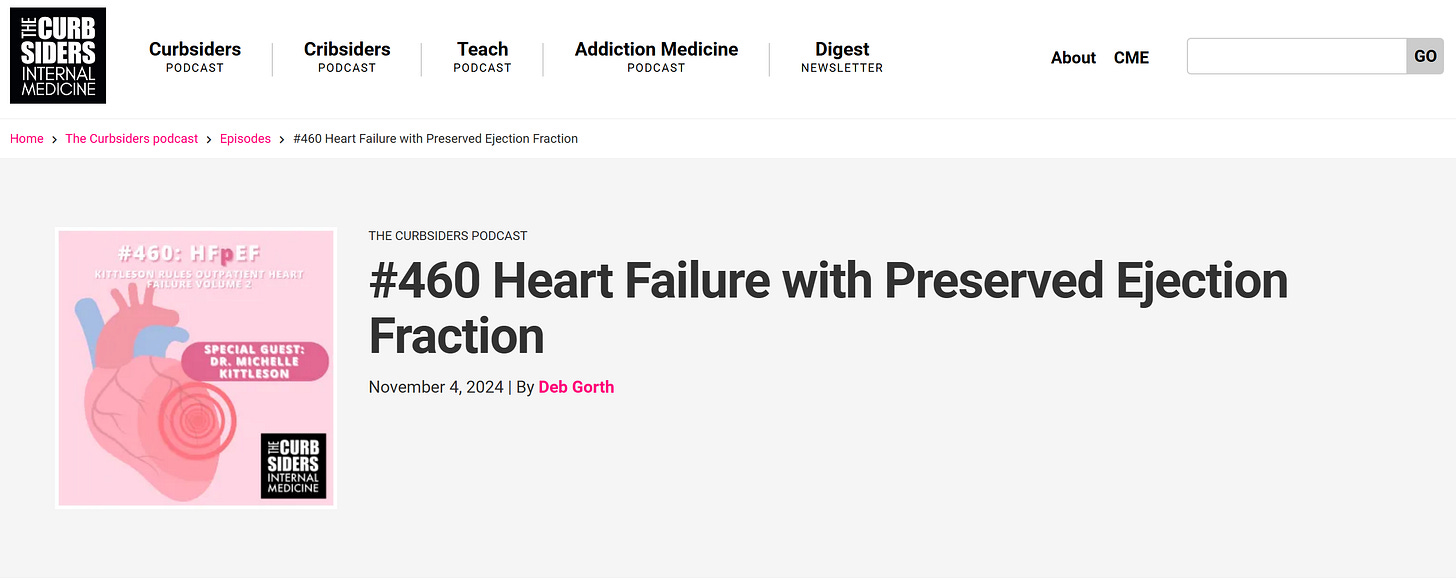
Source: https://thecurbsiders.com/curbsiders-podcast/460-heart-failure-with-preserved-ejection-fraction
- Are you sure the symptoms are actually from HFpEF? Similar symptoms can arise from a wide array of diseases, such as hepatic cirrhosis, renal failure, nephrotic syndrome, or venous insufficiency.
- Due to the stiff, non-compliant nature of the ventricle in HFpEF, small changes in volume can lead to large swings in filling pressures, making these patients particularly sensitive to dietary sodium.
- A normal BNP in an obese patient with compelling symptoms of volume overload should not dissuade one from the diagnosis
- Tools like the H2F-PEF score can be useful to estimate the probability of HFpEF, but one must not miss critical mimics including cardiac amyloidosis, which may be present in up to 15% of older adults hospitalized for HFpEF and now actually has treatments
- Early mitral inflow velocity / mitral annular early diastolic velocity (E/e’) ratio is a surrogate for left ventricular (LV) filling pressure.
- “E” is obtained with pulsed-wave doppler across the mitral valve and reflects trans mitral flow in early diastole
- “e′” is measured with tissue doppler at the mitral annulus (septal and lateral) and reflects the rate of myocardial relaxation.
- Because E rises with higher left atrial (LA) pressure while e′ falls with impaired relaxation, a higher E/e′ implies higher LV filling pressures, the hemodynamic signature of HFpEF.
- In practice, you measure e′ at both the septal and lateral annulus and use the average E/e′.
- An average E/e′ ≥ 14–15 at rest is generally considered abnormal and supports elevated LV filling pressure; an average ≤ 8 suggests normal pressure; and 9–14 is a gray zone that needs additional data.
- E/e′ is only a surrogate and its correlation with directly measured LV filling pressures is moderate; load dependence, heart rate, and rhythm matter.
- Accuracy falls in atrial fibrillation (there is beat-to-beat variability), significant mitral regurgitation or mitral annular calcification (distorts E or e′), regional wall-motion abnormalities or bundle-branch block (alters annular velocities), extremes of age and obesity (blunt e′), and in high-output states or acute ischemia
- The cornerstone of management of HFpEF involves addressing the comorbidities that are associated with it, including HTN, AFib, CKD, obesity, and sleep apnea.
- Sodium-glucose cotransporter-2 (SGLT2) inhibitors are now a key therapy; they were the first drug class to definitively meet primary endpoints in large randomized controlled trials, reducing the composite of cardiovascular death and heart failure hospitalizations. (EMPEROR-Preserved Trial) They should be considered for all symptomatic patients.
- Mineralocorticoid Receptor Antagonists (MRAs) like spironolactone hold a class 2b recommendation; despite the primary TOPCAT trial being neutral, subgroup analyses of patients from the Americas showed a benefit in reducing hospitalizations.
- Angiotensin Receptor-Neprilysin Inhibitors (ARNIs) - Entresto - also have a class 2b recommendation, having missed their primary endpoint in the PARAGON-HF trial, but may be considered, particularly for patients with lower-range ejection fractions or persistent hypertension.
- More recently, data from the STEP-HFpEF trial demonstrated that Glucagon-like peptide-1 (GLP-1) receptor agonists significantly improve symptoms, physical function, and weight in patients with obesity-related HFpEF, offering another tool
#498 Opioid Withdrawal (Curbsiders)
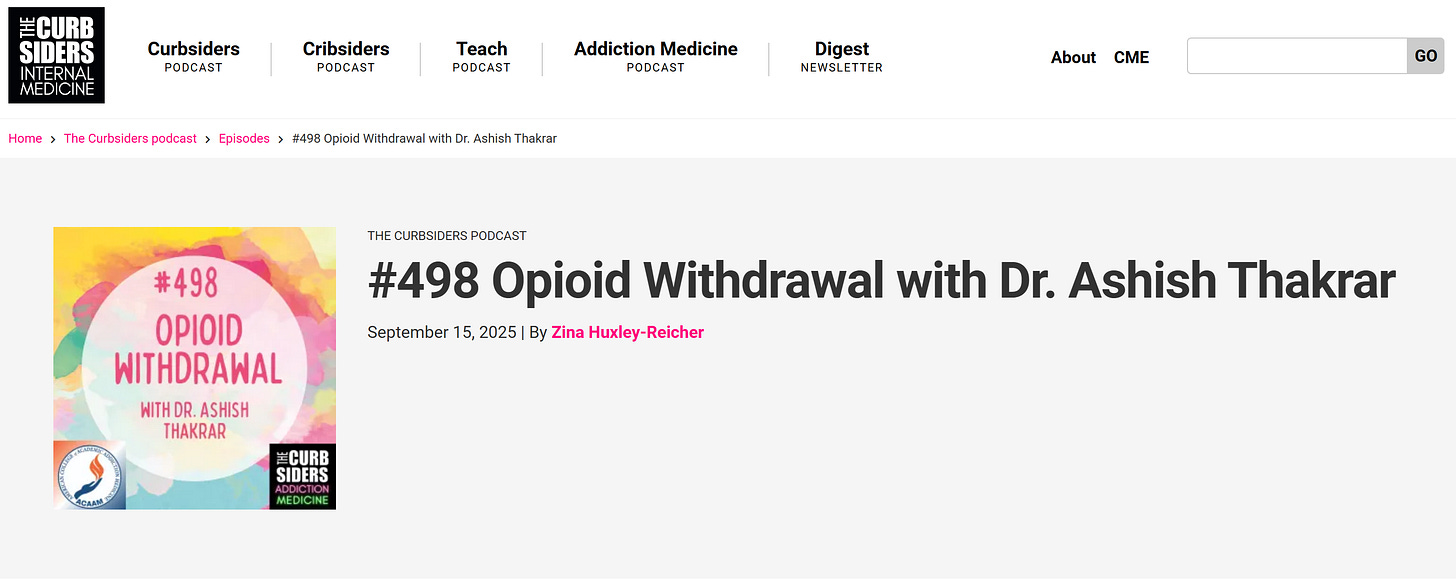
Source: https://thecurbsiders.com/curbsiders-podcast/498-opioid-withdrawal-with-dr-ashish-thakrar
- Fentanyl withdrawal lasts longer and is less predictable. Fentanyl is lipophilic and accumulates in body fat and muscle tissue; initial withdrawal can still happen within 6-12 hours, but peak intensity is often delayed up to 2-3 days after last use and can last 5-6 days.
- Four-bucket framework for managing withdrawal in the hospital:
- long-acting opioid as MAT - methadone or buprenorphine
- alpha-2 agonist like clonidine
- non-opioid symptom management medications
- short-acting full-agonist opioids
- The MAT choice made in the hospital to address withdrawal does not need to be a permanent one
- Buprenorphine-precipitated withdrawal is likely more common now due to fentanyl sticking around in tissue even when the patient begins to feel symptoms of withdrawal - pathways usually recommend starting the medication when signs of withdrawal appear
- Low-dose inductions (“micro-dosing”) add tiny amounts of buprenorphine while full agonists are continued to allow the body to adjust gradually; the goal is to avoid the precipitated withdrawal
- You can safely start with 30-40mg of methadone if a patient is regularly using fentanyl
- However, you need to be careful about dose-stacking methadone where repeated daily doses can accumulate and lead to over-sedation by days ~3-4
- In the first 24-48 hours, it’s nearly impossible to control withdrawal with methadone or buprenorphine alone, thus will routinely need to use hydromorphone 8mg PO or oxycodone 20mg PO scheduled around the clock to provide additional relief. Many will require far more than this. Once a patient is comfortable and on MAT, you can taper short-acting opioids within 48-72 hours
- Withdrawal from xylazine (and now medetomidine) often requires ICU level care for dexmedetomidine infusion to address the severe surge of hypertension, tachycardia, and tremors
Read the Point of Care Medicine content on OUD and Opioid Withdrawal!
One Detail Completely Changed This Case (An Unexpected Outcome) - Conan Liu MD
- A miscommunication (language barrier) led to the team misunderstanding the time course and location of a patient’s swelling.
- Patient presented with chief complaint of swelling in the face and neck leading to difficulty swallowing and sleeping. Given this type of swelling is atypical and possibly life threatening, along with the assumption that it was an acute change, clinicians anchored on angioedema and didn’t immediately realize that the patient had more diffuse body swelling.
- A re-framing of the illness script to anasarca led to realization the patient had low albumin and high lipids. This led to eventual diagnosis of proteinuria and minimal change disease
- Highlights the importance of taking each piece of information on its own. Many patients have low albumin from malnutrition or chronic illness, but in a patient who doesn’t necessarily fit those typical phenotypes, should be thinking about proteinuria or protein-losing enteropathy.
This video/case prompted me to do a deeper dive into thinking about patients with hypoalbuminemia. My lessons below:
- Hypoalbuminemia can be broken into three buckets - decreased synthesis (cirrhosis, malnutrition), increased loss (nephrotic syndrome, protein-losing enteropathy, severe burns), and inflammation-mediated (sepsis, malignancy) where albumin acts as a negative acute-phase reactant.
- The most common clinical sign of hypoalbuminemia is peripheral edema or anasarca due to loss of plasma oncotic pressure.
- Giving albumin is only valuable in limited clinical settings - SBP, HRS, and large-volume paracentesis where the goal is to stabilize circulation. It is not an effective treatment for correcting a low serum albumin level, as it does not address the underlying cause - it will either immediately be lost in the urine or stool like the albumin before it.
- Though historically some have tried using albumin to augment diuresis in nephrotic patients, the effect is modest and short-lived.
- Anasarca and edema due to low albumin in tough-to-reverse disease (cancer, malnutrition, sepsis and ICU level care) should address sodium restriction, avoiding unnecessary fluids, and creating steady natriuresis with loop diuretics with a modest and sustainable goal of net negative 1-2 liters per day.
- Promote elevation, ambulation, properly fitted compression wraps or stockings to augment lymphatic return. Provide adequate protein and calories to reduce catabolism, but focus mostly on what the patient will actually take in.
- In sum, with hypoalbuminemia and edema, stop adding salt and water, help the kidneys (or a filter) remove what’s already there, improve lymphatic return mechanically, drain symptomatic compartments, and treat any fixable outflow obstruction. Everything else, including albumin, plays only a supporting role.
UCSF Grand Rounds - Delirium
- Reframe delirium to not be a sign of irreversible decline, but as a critical opportunity to intervene and change a patient’s health trajectory
- UB-CAM and 4AT - app-based tools for rapid screening of delirium
- Distinct immune pathways are active during delirium
- Prevention works - use proactive order sets focused on mobility, sleep hygiene, and early screening
- Think of delirium as “acute brain failure” - the goal is to find and reverse the underlying cause
- When it comes to medication, subtracting is more important than adding - when able, take away opioid, benzos, anticholinergics
- Anti-psychotics do not treat or resolve delirium - use only when agitation poses a risk of harm to the patient or others and only after behavioral interventions have failed; when you do use them, try for the lowest dose for the shortest possible time
- Avoid prescribing antipsychotics on discharge - associated with a 30% increased risk of mortality!
- In the ICU, dexmedetomidine is a safer alternative to benzos or propofol
- Treat pain with non-opioids and address sleep-wake cycle disturbances with melatonin
- After a delirium episode, patients often do not fully recover their cognitive function; moreover, patients with high cognitive baseline see the steepest drops
Check out the Point of Care Medicine template on Delirium and Agitation!
UCSF Grand Grounds - Hepatitis C
- In the 1970’s hepatitis C was just known as “non-A, non-B” hepatitis.
- In 1989, the Hepatitis C virus was identified via molecular cloning.
- This meant it could be screened for in the blood supply - this essentially eliminated post-transfusion hepatitis in the U.S by the early 1990’s.
- In the late 1980’s, interferon monotherapy was standard of care and it was grueling.
- By 2011, standard management was a year long course of pegylated interferon and ribavirin - this course has debilitating side effects and only 50% chance of cure. Many patients were never even treated.
- In 2013, sobosbuvir, a direct-acting antiviral (DAA) was approved. These oral medications were well tolerated and achieved cure rates in 95% of cases.
- DAA medications prevent cirrhosis, cancer, and improve all-case mortality.
- Treatments are now pan-genotypic, all oral regimens like Mayvret (8 weeks), or Epclusa (12 weeks).
- While we have a cure, we are far from elimination. Rates of new infections are actually increasing due to the opioid epidemic. 2.4-4 million people in the US are estimated to be living with HepC. Only 1 in 3 of those diagnosed have actually been cured.
- Those with HepC are those least likely to engage meaningfully with the outpatient healthcare system and include those who are homeless, incarcerated, or who use injection drugs. New models bring care to these patients rather than expecting them to come to the clinic. Examples including treating patients at opioid treatment programs.
- FDA recently approved a point-of-care hepatitis C RNA finger-stick test that gets results within an hour.
- Future treatments may include long-acting injectables to bypass issues of adherence and follow up. True elimination will likely require a vaccine.
- Goal is to find it, confirm active viremia, stage liver disease, treat with pan-genotypic direct-acting antiviral (DAA), and keep people from getting reinfected
- If you consistently reflex-confirm viremia, stage fibrosis noninvasively, pick a pan-genotypic DAA with interactions in mind, and ensure SVR12 (sustained virologic response at 12 weeks) documentation plus cirrhosis-appropriate surveillance, you’ll cure the vast majority of your patients and prevent most long-term complications.
- Genotyping is no longer routinely required for treatment naive patient
- For most treatment-naïve adults without decompensated cirrhosis, two regimens cover nearly everyone: glecaprevir/pibrentasvir for eight weeks (extend to 12 weeks in compensated cirrhosis) or sofosbuvir/velpatasvir for 12 weeks. Both are once-daily (glecaprevir/pibrentasvir is three co-formulated tablets once daily with food) and have >95% cure rates.
- Before treating, send baseline labs and check for interactions
- When treatment is complete, check HCV RNA quant 12 weeks after the last dose to document sustained virologic response which means there is a cure
- There is no post-exposure prophylaxis for HCV


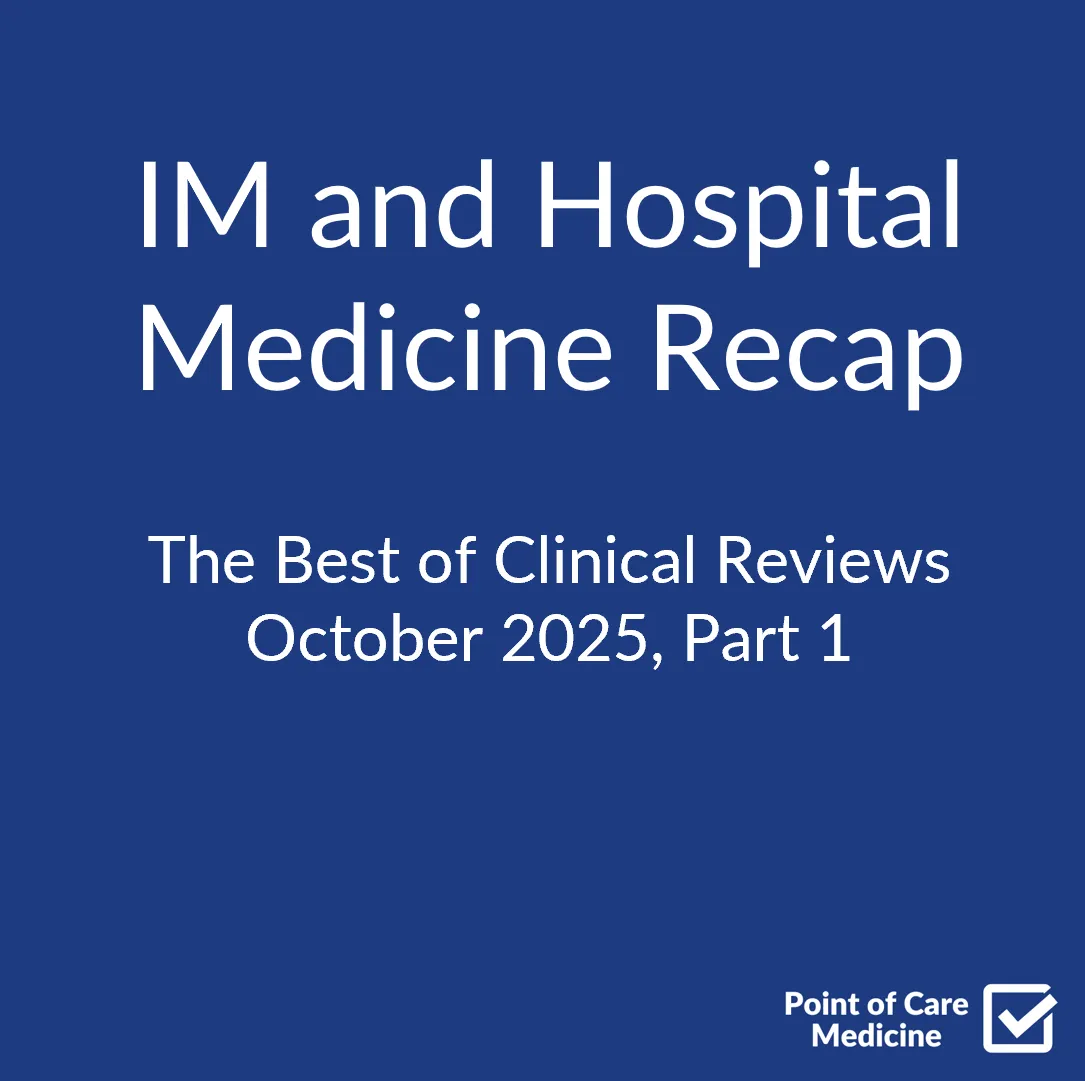
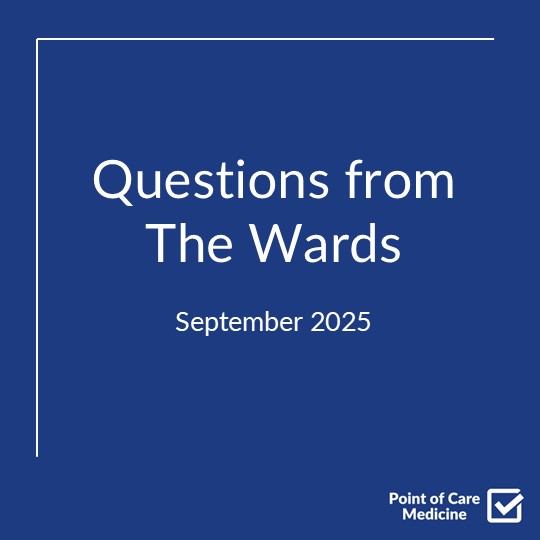



.png)
